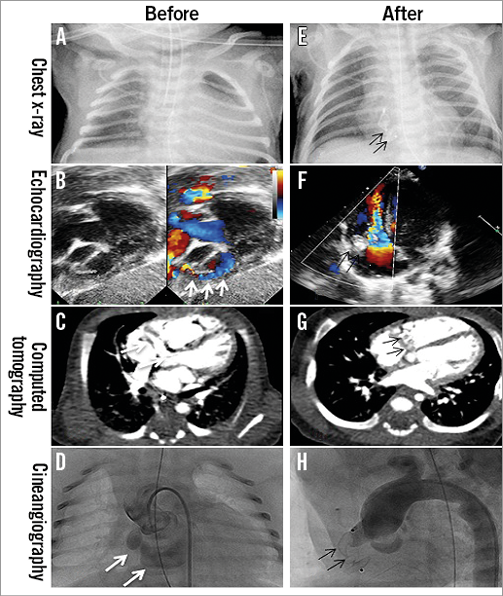A male baby, weighing 3,476 gm, was noted to have grade III/VI continuous murmur. Cardiomegaly was noted on his chest x-ray (Figure 1A). Echocardiography (Figure 1B) showed a large right coronary arteriovenous fistula (CAVF) with drainage to the right ventricle. Computed tomography (Figure 1C) demonstrated similar findings. Transcatheter closure of the 3.5 mm fistula was attempted at six days of age. Coronary cineangiography confirmed the diagnosis (Figure 1D, Moving image 1). An Amplatzer™ Duct Occluder II (9-PDA2-04-04; St. Jude Medical, St. Paul, MN, USA) was deployed smoothly (Figure 1E and 1H, Moving image 2). The post-procedural course was uneventful except for fluctuating saturation (90-95%). Echocardiography showed an acceleration of tricuspid antegrade flow (Figure 1F, Moving image 3), which may be related to the compression on the right atrioventricular groove by the device: this caused right to left shunt at the level of the foramen ovale. His saturation normalised four months later and echocardiography revealed the resolution of tricuspid stenosis. Concurrent computed tomography (Figure 1G) also showed that the fistula was completely occluded.

Figure 1. Image studies before and after transcatheter closure of a coronary fistula. (A-D) Before the closure, (E-H) after the closure, (F) device-related tricuspid stenosis. White arrows: coronary arteriovenous fistula; dark arrows: occluder
We suggest that the Amplatzer Duct Occluder II might be feasible for transcatheter closure of neonatal CAVF. Transient cyanosis due to device-related tricuspid stenosis should be monitored.
Conflict of interest statement
The authors have no conflicts of interest to declare.
Supplementary data
Moving image 1. Selective cineangiogram, lateral view of right coronary arteries.
Moving image 2. Ductal occluder deployment process.
Moving image 3. Tricuspid stenosis.
Supplementary data
To read the full content of this article, please download the PDF.
Moving image 1. Selective cineangiogram, lateral view of right coronary arteries.
Moving image 2. Ductal occluder deployment process.
Moving image 3. Tricuspid stenosis.

